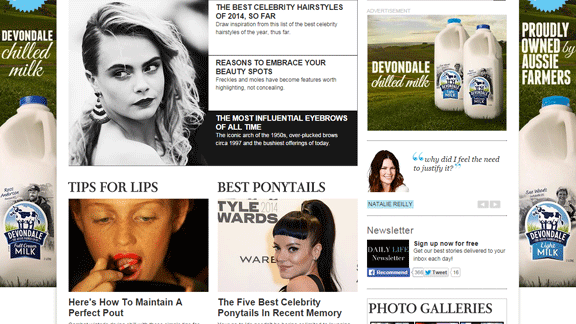Modern day women’s pages are beneath contempt

There’s a lot to be angry about in capitalist society – war, starvation, poverty, discrimination, oppression. But sometimes it’s the littlest things that hurt the most, like when the footy is being broadcast only on Foxtel, or anything to do with baby Prince George.
Somewhere in between these poles is Daily Life, the modern women’s pages in the Fairfax press.
Daily Life’s editor, Sarah Oakes, describes it as a “feisty, feminist site” that rallies against “the old-fashioned, patronising ideas of women and women’s content”.
To be sure, among the various sections – “Fashion”, “Beauty”, “Life and Love” – there is some hard-hitting, intellectually challenging material. For instance, in the first week of September, the site tackled such weighty issues as “will scrunchies make a comeback”, “decorating so that people think you’re amazing”, “how to break up with a friend” and “tips to clean a house in 30 minutes”. Similarly, there is no denying that it is at the forefront of scientific innovation. Where else can you read about the long-awaited research into whether sleeping in underwear constitutes a health risk or get the definitive verdict on which are the most influential eyebrows of all time?
And if all that gets a bit heavy or technical, there are always the “Hairy men we love” or “90s beauty icons to girl crush all over again” photo galleries for a bit of cyber-feminist light relief.
The “News and Views” section seems to be the sole concession on the part of the editors to the idea that the 1950s did indeed come to an end and that women are capable of engaging with content beyond that which might interest an unusually intelligent zoo animal.
But it is also the only section in which women don’t constitute a majority of contributors. Other sections, from “popular culture” to “nutrition”, are written almost solely by women. And although I personally learnt a lot from “More reasons to love Melinda Gates” and “Is Gina Rinehart a feminist?”, the reality is it engages with virtually no substantial issues of world politics or economics, presumably because women aren’t interested or suited to getting our heads around such things.
The worst aspect of Daily Life is not the patronising, stereotyped content that assumes women cannot relate to anything outside of their personal experience or banal trivialities. It’s that the entire site has nothing to do with the mainstream media taking women more seriously. It is instead an elaborate vehicle to sell premium advertising space to corporations that prey on women’s insecurities and profit from sexism.
Which is why you cannot read Daily Life without seeing an advertisement for cosmetic surgery clinics, weight loss programs or online fashion retailers urging you to “get the look”. And it is why all the pages on Daily Life are available for free – they are worthless click-bait aimed at selling advertising space.
Fairfax packages this to potential advertisers through the Fairfax Women’s Network, a “portfolio of brands with diverse female audiences that gives advertisers the power to engage with more than three million Australian women at different life stages”.
This is a major revenue growth area, generating millions through Daily Life, RSVP, Cuisine, Essential Baby and Essential Kids.
Dressed up as quasi-political social commentary, Daily Life is nothing more than 1950s-style women’s pages reinvented to sell advertising. Which is all pretty old-fashioned, if you ask me. Those who use it to advance careers as social commentators only provide legitimacy to a forum that does far more to reinforce women’s oppression than to challenge it.